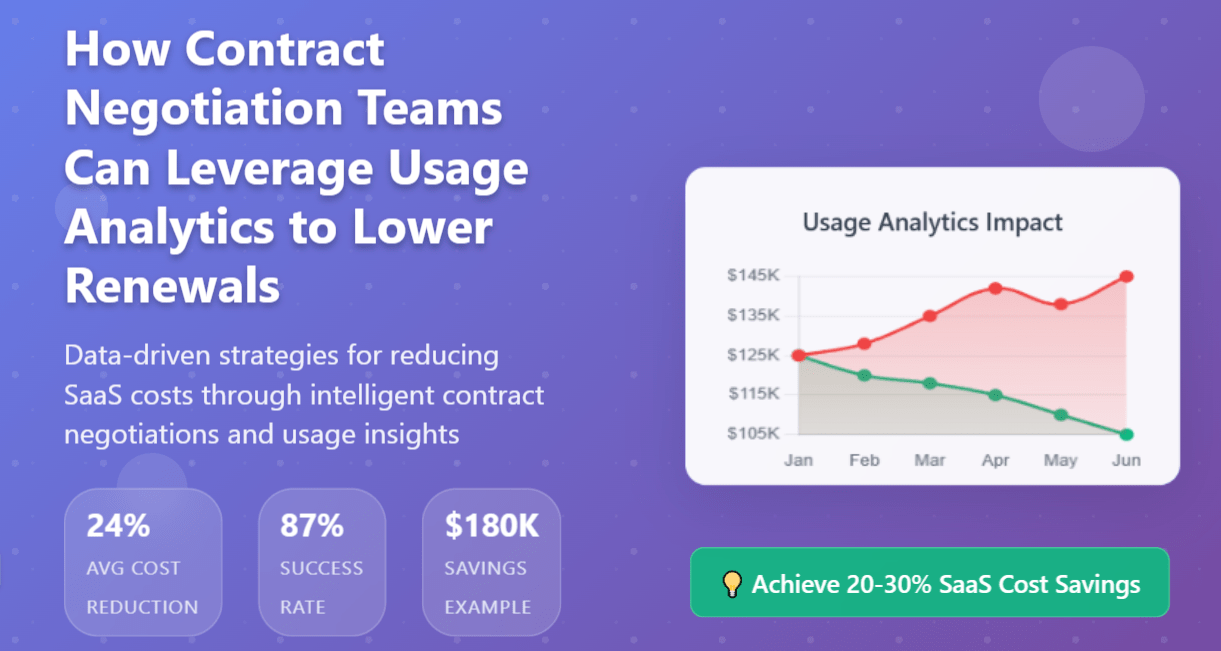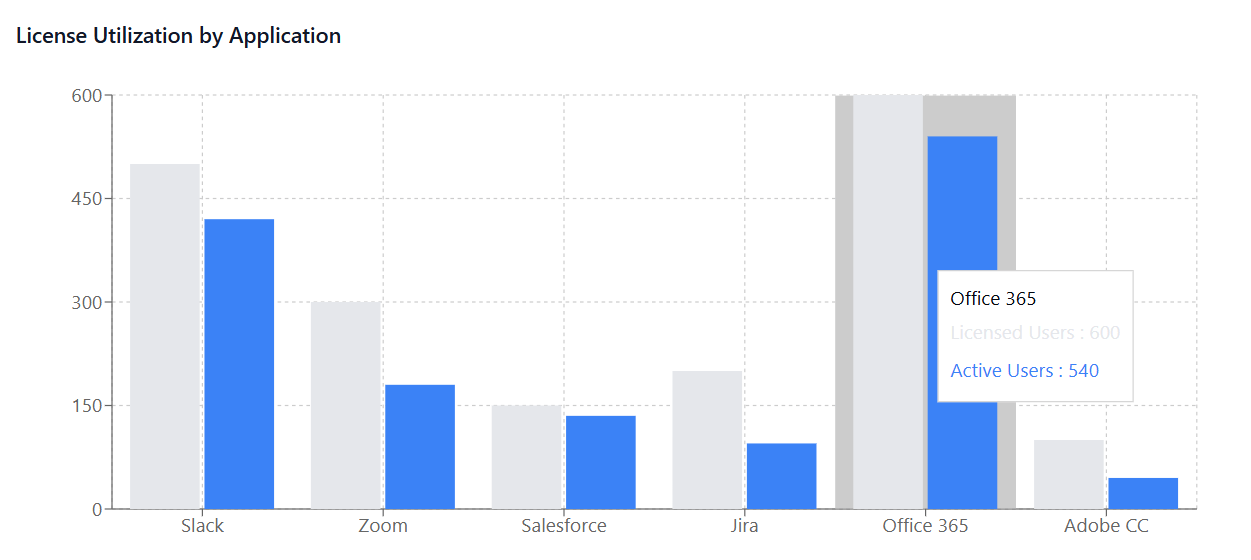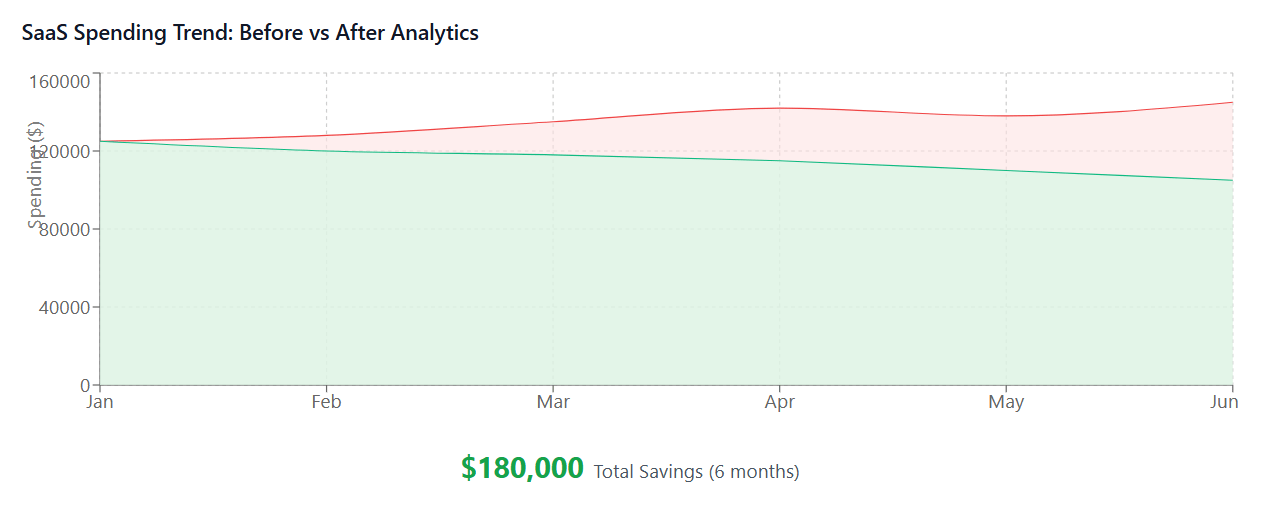
In today’s rapidly evolving digital landscape, organizations rely heavily on Software as a Service (SaaS) solutions to power their operations. With the average enterprise using over 80 SaaS applications, managing software subscriptions and renewal costs has become increasingly complex and critical for maintaining healthy profit margins.
Contract negotiation teams find themselves at the forefront of SaaS spend management, tasked with securing favorable terms while ensuring business continuity. The traditional approach of negotiating based on vendor proposals and historical usage patterns is no longer sufficient in a world where usage analytics provide unprecedented visibility into actual software utilization.
This comprehensive guide explores how contract negotiation teams can harness the power of usage analytics to significantly reduce SaaS renewal costs. By leveraging data-driven insights, organizations can transform their approach to SaaS procurement and achieve substantial cost savings while maintaining operational efficiency.
The integration of usage analytics into contract negotiations represents a paradigm shift from reactive to proactive SaaS management. Organizations that master this approach typically see 20-30% reductions in their overall SaaS spending, making it an essential capability for modern procurement teams.
Understanding Usage Analytics in SaaS Environments
Usage analytics provide detailed insights into how employees interact with SaaS applications, revealing patterns that are invisible through traditional monitoring methods. These analytics encompass a wide range of metrics, from basic login frequencies to advanced feature utilization rates, providing contract negotiation teams with powerful ammunition for renewal discussions.
Core Components of SaaS Usage Analytics
User Activity Monitoring tracks individual and departmental engagement levels across different SaaS platforms. This includes login frequency, session duration, and active usage periods, which help identify underutilized licenses and opportunities for subscription optimization.
Feature Utilization Analysis examines which specific features within SaaS applications are being used and which remain dormant. This granular visibility enables negotiation teams to identify opportunities to downgrade to lower-tier plans or eliminate unnecessary add-ons that contribute to subscription bloat.
Departmental Usage Patterns reveal how different teams within the organization utilize SaaS tools, enabling more accurate forecasting of future needs and better alignment of software subscriptions with actual business requirements.
Integration Dependencies track how SaaS applications interact with other systems in the technology stack, helping negotiation teams understand the true value proposition of each tool and identify potential consolidation opportunities.
The Business Impact of Usage Analytics
Organizations leveraging usage analytics for contract negotiations report significant improvements in their SaaS spend management efficiency. By understanding actual utilization patterns, teams can challenge vendor assumptions and negotiate from a position of strength backed by concrete data.
The visibility provided by usage analytics also enables organizations to identify shadow IT practices, where departments purchase SaaS solutions independently without going through proper procurement channels. This discovery process often reveals redundant subscriptions and unauthorized spending that can be eliminated during renewal negotiations.
The Role of Contract Negotiation Teams in SaaS Management
Modern contract negotiation teams must evolve beyond traditional procurement practices to become strategic SaaS spend management partners. This transformation requires developing new competencies in data analysis, usage pattern interpretation, and value-based negotiation strategies.
Strategic Positioning for Success
Effective negotiation teams position themselves as cost optimization partners rather than simply procurement executors. This strategic positioning enables them to engage with vendors as informed stakeholders who understand both the technical and business value of SaaS solutions.
The most successful teams establish strong relationships with IT departments and end users to gain comprehensive insights into software utilization patterns. This collaboration ensures that negotiation strategies align with actual business needs while maximizing cost-saving opportunities.
Data-Driven Decision Making
Usage analytics empower negotiation teams to make informed decisions based on empirical evidence rather than vendor projections or historical assumptions. This data-driven approach strengthens negotiating positions and enables teams to challenge pricing models that don’t align with actual usage patterns.
Teams that effectively leverage usage analytics often discover significant discrepancies between contracted licenses and actual utilization, providing substantial leverage during renewal negotiations. These insights enable them to right-size subscriptions and eliminate waste while maintaining necessary functionality.
Key Usage Metrics for Contract Negotiations
Understanding which metrics provide the most negotiation leverage is crucial for contract teams seeking to optimize SaaS renewal costs. Different types of usage data offer varying levels of insight and negotiating power.
License Utilization Rates
Active User Metrics reveal the percentage of licensed users who actually engage with SaaS applications on a regular basis. These metrics often uncover significant overprovisioning, where organizations pay for far more licenses than necessary.
Peak Usage Analysis identifies the maximum concurrent user loads during different periods, helping teams understand true capacity requirements and negotiate more appropriate subscription levels.
Seasonal Usage Patterns provide insights into cyclical usage trends that can inform flexible licensing arrangements or temporary scaling options during renewal negotiations.
Feature Adoption and Engagement
Feature Utilization Rates show which specific features within SaaS applications are actively used versus those that remain untouched. This data enables negotiation teams to challenge premium pricing for advanced features that provide little value to the organization.
User Proficiency Metrics indicate how effectively users leverage available functionality, helping teams identify training needs or opportunities to consolidate similar tools across different departments.
Integration Usage tracks how SaaS applications connect with other systems, providing insights into the true value proposition and potential switching costs during vendor negotiations. For comprehensive guidance on cloud integration strategies, explore our cloud computing terminology guide.
Cost-Effectiveness Analysis
Per-User Cost Efficiency calculates the actual cost per active user, enabling comparison across different SaaS providers and identification of the most cost-effective solutions.
Return on Investment Metrics quantify the business value generated by SaaS investments, providing negotiation teams with data to support value-based pricing discussions.
Comparative Usage Analysis benchmarks utilization patterns against industry standards, helping teams identify areas where their organization may be over or under-utilizing specific SaaS solutions.

Strategic Approaches to Lower Renewal Costs
Armed with comprehensive usage analytics, contract negotiation teams can employ various strategic approaches to achieve significant cost reductions during SaaS renewals. These strategies require careful planning and execution to maximize their effectiveness.
Right-Sizing Subscriptions
The most immediate opportunity for cost reduction comes from aligning subscription levels with actual usage patterns. Usage analytics provide the evidence needed to challenge vendor assumptions about required licensing levels and negotiate more appropriate subscription tiers.
Eliminating Unused Licenses represents the quickest path to cost savings. Analytics often reveal that 20-30% of licensed users remain inactive or minimally engaged, providing clear justification for subscription reductions.
Optimizing Feature Packages involves analyzing feature utilization to identify opportunities for downgrading to lower-tier plans that still meet actual business requirements. This approach can yield substantial savings while maintaining necessary functionality.
Departmental Optimization uses usage analytics to optimize subscriptions at the department level, ensuring that each team has appropriate access without over-provisioning across the organization.
Value-Based Negotiation Strategies
Usage analytics enable negotiation teams to shift from price-based to value-based discussions with SaaS vendors. This approach focuses on aligning pricing with actual business value delivered rather than simply negotiating volume discounts.
Performance-Based Pricing uses usage data to propose pricing models tied to actual utilization or business outcomes. This approach can result in significant cost savings for organizations with below-average usage patterns.
Flexible Scaling Arrangements leverage usage analytics to negotiate dynamic pricing models that adjust based on actual consumption, providing cost protection during periods of reduced activity.
Outcome-Based Contracts use usage analytics to establish pricing tied to specific business metrics or performance indicators, aligning vendor incentives with customer value realization.
Consolidation and Standardization
Usage analytics often reveal opportunities for consolidating multiple SaaS solutions or standardizing on preferred platforms across the organization. These strategies can provide significant negotiating leverage and cost savings.
Vendor Consolidation involves identifying overlapping functionality across different SaaS providers and negotiating comprehensive packages that eliminate redundancy while potentially securing volume discounts.
Platform Standardization uses usage data to identify the most effective SaaS solutions for specific use cases and negotiate organization-wide licenses that replace multiple competing tools.
Integration Optimization leverages analytics to identify opportunities for better integration between existing SaaS tools, potentially eliminating the need for additional middleware or connector solutions.

Best Practices for Implementation
Successfully implementing usage analytics in contract negotiations requires careful planning, proper tool selection, and ongoing process refinement. Organizations that follow established best practices achieve better results and avoid common implementation pitfalls.
Establishing Analytics Infrastructure
Comprehensive Monitoring Setup ensures that usage analytics capture all relevant SaaS applications across the organization. This includes both officially sanctioned tools and shadow IT solutions that may not be under formal management.
Data Quality Assurance implements processes to ensure that usage analytics are accurate, complete, and up-to-date. Poor data quality can undermine negotiation positions and lead to suboptimal outcomes.
Integration with Existing Systems connects usage analytics platforms with existing IT management tools, financial systems, and procurement workflows to create a comprehensive view of SaaS spend management.
Building Internal Capabilities
Cross-Functional Collaboration establishes strong working relationships between contract negotiation teams, IT departments, finance teams, and end users to ensure comprehensive understanding of SaaS utilization patterns.
Analytics Interpretation Skills develops internal capabilities to properly analyze and interpret usage data, ensuring that negotiation teams can effectively leverage insights during vendor discussions.
Vendor Relationship Management maintains productive relationships with SaaS vendors while using usage analytics to drive more favorable contract terms. This balance is crucial for long-term success.
Process Optimization
Regular Usage Reviews establishes ongoing processes to monitor SaaS utilization patterns and identify optimization opportunities throughout contract terms, not just during renewal periods.
Renewal Planning Cycles integrates usage analytics into formal renewal planning processes, ensuring that data-driven insights inform negotiation strategies well in advance of contract expiration dates.
Continuous Improvement implements feedback loops to refine analytics collection and interpretation processes based on negotiation outcomes and changing business requirements.
Common Pitfalls and How to Avoid Them
Even organizations with robust usage analytics capabilities can encounter challenges when implementing data-driven contract negotiation strategies. Understanding common pitfalls helps teams avoid costly mistakes and maximize their success.
Data Interpretation Challenges
Over-Reliance on Short-Term Data can lead to incorrect conclusions about long-term usage patterns. Seasonal fluctuations, project-based usage, and business cycle variations require careful consideration when interpreting analytics for negotiation purposes.
Ignoring User Context involves focusing solely on quantitative metrics without considering qualitative factors such as user satisfaction, business criticality, or strategic importance of specific SaaS applications.
Misunderstanding Vendor Metrics occurs when teams assume that vendor-provided usage data aligns with their own analytics. Discrepancies between internal and vendor metrics can create confusion during negotiations.
Negotiation Strategy Missteps
Aggressive Cost-Cutting without considering business impact can damage vendor relationships and potentially compromise service quality or feature access that proves critical for business operations.
Insufficient Preparation involves entering negotiations without comprehensive understanding of usage patterns, alternative solutions, or market pricing benchmarks that could strengthen negotiating positions.
Poor Timing of renewal discussions can limit negotiation leverage. Organizations achieve better results when they begin renewal planning well in advance of contract expiration dates.
Organizational Challenges
Resistance to Change from end users who prefer familiar tools can complicate efforts to consolidate or optimize SaaS subscriptions based on usage analytics insights.
Lack of Executive Support can undermine negotiation efforts when teams lack authority to make decisions based on usage analytics or implement recommended changes.
Inadequate Communication between different stakeholders can lead to misaligned expectations and suboptimal negotiation outcomes.
Technology Solutions and Tools
Effective usage analytics require robust technology platforms that can collect, analyze, and present SaaS utilization data in actionable formats. Modern SaaS spend management tools provide sophisticated capabilities that enable data-driven contract negotiations.
SaaS Management Platforms
Comprehensive SaaS management platforms like Binadox provide centralized visibility into software subscriptions, usage patterns, and cost optimization opportunities. These platforms typically offer automated discovery of SaaS applications, usage monitoring, and renewal management capabilities that support contract negotiation efforts.
Automated Discovery capabilities identify all SaaS applications in use across the organization, including shadow IT solutions that may not be under formal management. This comprehensive visibility is essential for effective contract negotiations. Learn more about automated SaaS discovery tools and their impact on cost optimization.
Usage Analytics Dashboards provide intuitive visualizations of SaaS utilization patterns, making it easy for negotiation teams to identify optimization opportunities and support their positions with compelling data presentations.
Renewal Management features track contract expiration dates, renewal terms, and negotiation timelines to ensure that teams have adequate preparation time for data-driven discussions with vendors.
Integration and Analytics Tools
API-Based Integrations enable direct connection with SaaS applications to gather detailed usage data without relying on manual reporting or vendor-provided metrics that may not align with organizational needs.
Business Intelligence Platforms can be configured to analyze SaaS usage data alongside other business metrics, providing comprehensive insights into the relationship between software utilization and business performance. For organizations managing multi-cloud environments, implementing cloud cost optimization strategies alongside SaaS analytics creates a holistic approach to technology spend management.
Cost Allocation Tools help organizations understand the true cost of SaaS applications by department, project, or business unit, enabling more targeted negotiation strategies and budget optimization efforts.
Measuring Success and ROI
Demonstrating the value of usage analytics-driven contract negotiations requires establishing clear success metrics and tracking outcomes over time. Organizations that effectively measure results can refine their approaches and justify continued investment in analytics capabilities.
Financial Impact Metrics
Direct Cost Savings measure the immediate reduction in SaaS spending achieved through negotiated contract improvements. These savings should be tracked both in absolute terms and as percentages of previous spending levels.
Avoided Cost Increases quantify the value of preventing vendor-proposed price increases or maintaining favorable terms that might otherwise have been lost without data-driven negotiation approaches.
Total Cost of Ownership Optimization considers not just subscription costs but also implementation, training, and integration expenses to provide a comprehensive view of SaaS spend management effectiveness.
Operational Efficiency Gains
Process Improvement Metrics track reductions in time and effort required for contract negotiations, renewal management, and SaaS spend management activities resulting from improved analytics capabilities.
Decision-Making Speed measures how quickly negotiation teams can respond to vendor proposals and market changes when armed with comprehensive usage analytics and insights.
Risk Reduction quantifies improvements in contract terms, service level agreements, and vendor accountability that result from data-driven negotiation approaches.
Strategic Value Creation
Business Alignment measures how effectively SaaS subscriptions align with actual business needs and usage patterns following analytics-driven optimization efforts.
Innovation Enablement tracks the organization’s ability to adopt new SaaS solutions and capabilities more effectively by understanding utilization patterns and optimization opportunities.
Competitive Advantage assesses the strategic benefits of more efficient SaaS spend management and better vendor relationships resulting from data-driven negotiation approaches.
Conclusion
The integration of usage analytics into contract negotiation strategies represents a fundamental shift in how organizations approach SaaS spend management. By leveraging detailed insights into actual software utilization patterns, negotiation teams can achieve significant cost reductions while ensuring that technology investments align with business needs.
Successful implementation requires commitment to building analytics capabilities, developing cross-functional collaboration, and maintaining focus on value creation rather than simply cost reduction. Organizations that master these approaches typically achieve 20-30% reductions in SaaS spending while improving service quality and user satisfaction.
The rapidly evolving SaaS ecosystem demands sophisticated approaches to contract negotiation and spend management. Usage analytics provide the foundation for these capabilities, enabling organizations to navigate vendor relationships with confidence and achieve optimal outcomes for their technology investments.
As SaaS adoption continues to accelerate across industries, the ability to leverage usage analytics for contract negotiations will become increasingly critical for organizational success. Teams that develop these capabilities now will be well-positioned to manage growing software portfolios effectively while maintaining cost discipline and operational efficiency.
The future of SaaS spend management lies in data-driven decision making, strategic vendor partnerships, and continuous optimization based on real-world usage patterns. Organizations that embrace these principles and invest in appropriate analytics capabilities will achieve sustainable competitive advantages in their software procurement and management practices.
By implementing the strategies and best practices outlined in this guide, contract negotiation teams can transform their approach to SaaS renewals and deliver measurable value to their organizations. The combination of robust usage analytics, strategic negotiation approaches, and continuous improvement processes provides a proven framework for achieving exceptional results in SaaS spend management.
Organizations looking to implement these strategies can benefit from comprehensive SaaS management solutions that provide the analytics foundation necessary for successful contract negotiations. With the right tools and approach, teams can consistently achieve the 20-30% cost reductions highlighted throughout this guide while maintaining optimal software functionality for their users.

